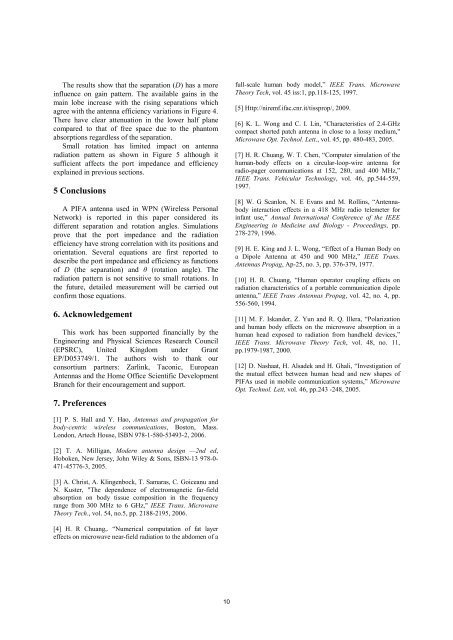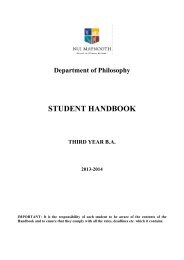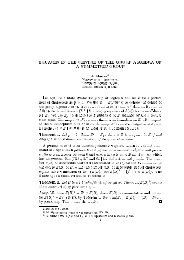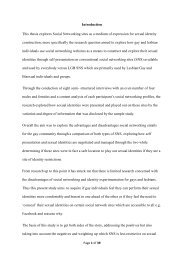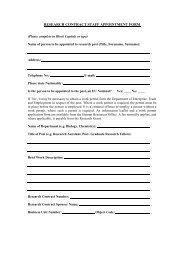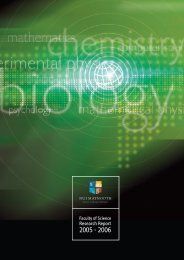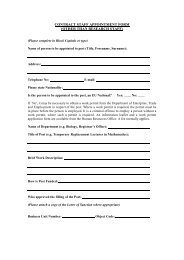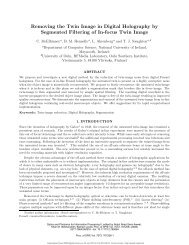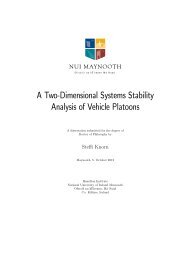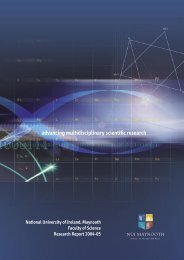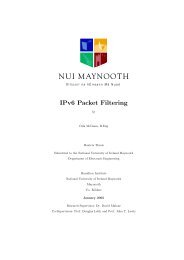CIICT 2009 Proceedings
CIICT 2009 Proceedings
CIICT 2009 Proceedings
- No tags were found...
You also want an ePaper? Increase the reach of your titles
YUMPU automatically turns print PDFs into web optimized ePapers that Google loves.
The results show that the separation (D) has a moreinfluence on gain pattern. The available gains in themain lobe increase with the rising separations whichagree with the antenna efficiency variations in Figure 4.There have clear attenuation in the lower half planecompared to that of free space due to the phantomabsorptions regardless of the separation.Small rotation has limited impact on antennaradiation pattern as shown in Figure 5 although itsufficient affects the port impedance and efficiencyexplained in previous sections.5 ConclusionsA PIFA antenna used in WPN (Wireless PersonalNetwork) is reported in this paper considered itsdifferent separation and rotation angles. Simulationsprove that the port impedance and the radiationefficiency have strong correlation with its positions andorientation. Several equations are first reported todescribe the port impedance and efficiency as functionsof D (the separation) and θ (rotation angle). Theradiation pattern is not sensitive to small rotations. Inthe future, detailed measurement will be carried outconfirm those equations.6. AcknowledgementThis work has been supported financially by theEngineering and Physical Sciences Research Council(EPSRC), United Kingdom under GrantEP/D053749/1. The authors wish to thank ourconsortium partners: Zarlink, Taconic, EuropeanAntennas and the Home Office Scientific DevelopmentBranch for their encouragement and support.7. Preferencesfull-scale human body model,” IEEE Trans. MicrowaveTheory Tech, vol. 45 iss:1, pp.118-125, 1997.[5] Http://niremf.ifac.cnr.it/tissprop/, <strong>2009</strong>.[6] K. L. Wong and C. I. Lin, "Characteristics of 2.4-GHzcompact shorted patch antenna in close to a lossy medium,"Microwave Opt. Technol. Lett., vol. 45, pp. 480-483, 2005.[7] H. R. Chuang, W. T. Chen, “Computer simulation of thehuman-body effects on a circular-loop-wire antenna forradio-pager communications at 152, 280, and 400 MHz,”IEEE Trans. Vehicular Technology, vol. 46, pp.544-559,1997.[8] W. G Scanlon, N. E Evans and M. Rollins, “Antennabodyinteraction effects in a 418 MHz radio telemeter forinfant use,” Annual International Conference of the IEEEEngineering in Medicine and Biology - <strong>Proceedings</strong>, pp.278-279, 1996.[9] H. E. King and J. L. Wong, “Effect of a Human Body ona Dipole Antenna at 450 and 900 MHz,” IEEE Trans.Antennas Propag, Ap-25, no. 3, pp. 376-379, 1977.[10] H. R. Chuang, “Human operator coupling effects onradiation characteristics of a portable communication dipoleantenna,” IEEE Trans Antennas Propag, vol. 42, no. 4, pp.556-560, 1994.[11] M. F. Iskander, Z. Yun and R. Q. Illera, “Polarizationand human body effects on the microwave absorption in ahuman head exposed to radiation from handheld devices,”IEEE Trans. Microwave Theory Tech, vol. 48, no. 11,pp.1979-1987, 2000.[12] D. Nashaat, H. Alsadek and H. Ghali, “Investigation ofthe mutual effect between human head and new shapes ofPIFAs used in mobile communication systems,” MicrowaveOpt. Technol. Lett, vol. 46, pp.243 -248, 2005.[1] P. S. Hall and Y. Hao, Antennas and propagation forbody-centric wireless communications, Boston, Mass.London, Artech House, ISBN 978-1-580-53493-2, 2006.[2] T. A. Milligan, Modern antenna design —2nd ed,Hoboken, New Jersey, John Wiley & Sons, ISBN-13 978-0-471-45776-3, 2005.[3] A. Christ, A. Klingenbock, T. Samaras, C. Goiceanu andN. Kuster, "The dependence of electromagnetic far-fieldabsorption on body tissue composition in the frequencyrange from 300 MHz to 6 GHz," IEEE Trans. MicrowaveTheory Tech., vol. 54, no.5, pp. 2188-2195, 2006.[4] H. R Chuang,. “Numerical computation of fat layereffects on microwave near-field radiation to the abdomen of a10


